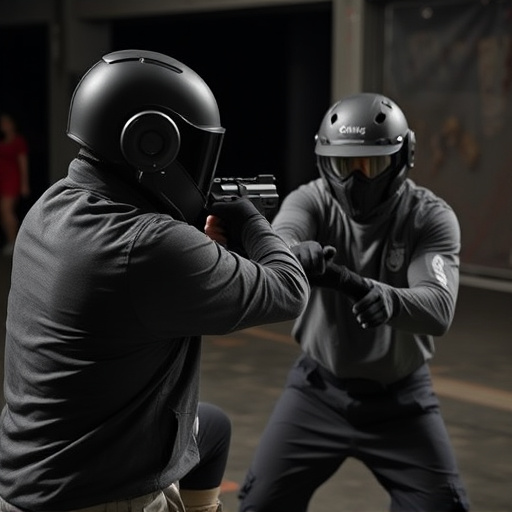Selecting the best pepper spray delivery methods is crucial for self-defense. Aerosol canisters and gel formulations offer distinct advantages; aerosols for wide coverage, gels for targeted application. Key factors include ease of use under stress, advanced mechanisms to prevent accidental discharge, capsaicin concentration, legal considerations, and safety training. Understanding these options ensures swift and effective protection in potentially dangerous situations.
In today’s unpredictable world, knowing how to defend yourself is paramount. Among non-lethal self-defense tools, inflammatory agents like pepper spray offer a powerful yet safe option. This article delves into the intricacies of these tools, covering key features for effectiveness, exploring popular delivery methods (spray, aerosol, gel), and examining legal implications. Understanding the best pepper spray delivery methods can empower folks to protect themselves confidently while adhering to safety guidelines.
- Understanding Non-Lethal Inflammatory Self-Defense Tools
- Key Features to Consider for Effective Pepper Spray
- Popular Delivery Methods: Spray, Aerosol, and Gel
- Legal Implications and Safety Guidelines for Self-Defense Pepper Spray
Understanding Non-Lethal Inflammatory Self-Defense Tools
Non-lethal inflammatory self-defense tools, such as pepper spray, offer individuals a powerful yet non-fatal means of protecting themselves in potentially dangerous situations. These tools are designed to temporarily incapacitate an assailant by causing discomfort and irritation, allowing the user to escape or seek help. Understanding the best pepper spray delivery methods is crucial for maximizing their effectiveness.
Among various delivery mechanisms, aerosol canisters and gel formulations stand out as the most common and reliable. Aerosol pepper spray projects a cloud of irritants, ensuring broad area coverage. This method is ideal for open spaces where the user can create a barrier between themselves and the assailant. Gel-based sprays, on the other hand, offer better control and accuracy, making them suitable for close-quarters combat or specific targeting of sensitive areas. The choice between these delivery methods ultimately depends on the situation at hand, personal preference, and the level of protection required.
Key Features to Consider for Effective Pepper Spray
When considering a non-lethal inflammatory self-defense tool like pepper spray, several key features determine its effectiveness. Firstly, pepper spray delivery methods play a pivotal role in ensuring swift and accurate application. The best systems offer easy operation, even under stress, with features like finger-tip activation or advanced mechanisms that prevent accidental discharge.
Additionally, the concentration of capsaicin, the active ingredient, significantly impacts its potency. Higher concentrations provide longer-lasting effects and greater stop-power. However, they may also increase irritation and potential side effects. It’s crucial to balance these factors based on intended use scenarios, whether for personal defense or professional applications like law enforcement.
Popular Delivery Methods: Spray, Aerosol, and Gel
In the realm of non-lethal self-defense tools, pepper spray has emerged as a popular and effective option. When it comes to deploying this powerful agent, several delivery methods have gained popularity, each offering unique advantages for personal safety. Among the best pepper spray delivery methods are spray, aerosol, and gel formulations.
Spray canisters are perhaps the most common and widely used form. They provide a simple and direct way to apply pepper spray, allowing users to quickly create a barrier between themselves and potential threats. Aerosol cans also offer ease of use, often featuring triggers that dispense the agent in a fine mist, ensuring maximum coverage. Gel-based pepper sprays are another favorite among self-defense enthusiasts. These gels can be applied directly to hands or clothing, offering controlled and targeted deployment. This method is particularly useful for those who prefer a more precise approach, enabling them to direct the spray directly at attackers.
Legal Implications and Safety Guidelines for Self-Defense Pepper Spray
When it comes to self-defense, using pepper spray as a non-lethal inflammatory tool has gained popularity for its effectiveness in neutralizing assailants while allowing time for escape. However, understanding legal implications is crucial before employing this method. The legality of carrying and using pepper spray varies by jurisdiction; some areas permit it with restrictions, while others may have strict regulations or outright ban its possession. It’s essential to research and comply with local laws to avoid legal repercussions.
Safety guidelines must also be strictly adhered to. Pepper spray should only be used as a last resort when facing imminent physical harm. Individuals should receive proper training on its use, including understanding the best pepper spray delivery methods, such as aiming for the eyes and face, where it’s most effective. Regular maintenance and expiration dates of the spray should be checked to ensure its potency remains effective. Safety precautions include keeping it out of reach of children and storing it in a secure, labeled container.
Non-lethal inflammatory self-defense tools, particularly pepper spray, offer a powerful yet safe option for personal protection. By understanding key features like active ingredients, delivery methods such as spray, aerosol, or gel, and adhering to legal guidelines, individuals can make informed choices to enhance their safety. The best pepper spray delivery methods ensure quick deployment and maximum effectiveness, allowing users to defend themselves effectively while mitigating risk.
